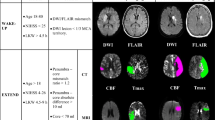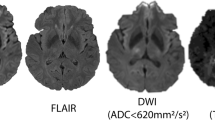Abstract
Intravenous alteplase given in an appropriate time window has been recommended in guidelines and effects are on the decline over time. In general, the clinical decision is primarily based on whether ischemic stroke patients are sent to hospitals within the time window. However, some patients sent to the hospital over time limitations are eligible to receive intervention for recanalization due to good collateral circulation. In this dilemma, “tissue window” can be more reliable, which means using the penumbra as a major criterion for patient recruitment. Hence, we herein aim to address how could “tissue window” be a complementary approach when it does not conform to the time window’s indication and affirming value of the later one. Some efforts obeying the time window are discussed first. In the later sections, we give the details of the definition of “tissue window”, and then compare various neuroimaging techniques to determine the penumbra and summarize favorable patterns. Finally, we will focus on how the “tissue window” extends the therapeutic time window under specific circumstances.
Similar content being viewed by others
References
Burke JF, Lisabeth LD, Brown DL, Reeves MJ, Morgenstern LB (2012) Determiningstroke’s rank as a cause of death using multicause mortality data. Stroke 43:2207–2211. https://doi.org/10.1161/STROKEAHA.112.656967
Hacke W (2018) A new dawn for imaging-based selection in the treatment of acute stroke. N Engl J Med 378:81. https://doi.org/10.1056/NEJMe1713367
Toni D, Chamorro A, Kaste M, Lees K, Wahlgren NG, Hacke W et al (2004) Acute treatment of ischaemic stroke. European stroke initiative. Cerebrovasc Dis 17(Suppl 2):30–46. https://doi.org/10.1159/000074818
Lees KRBE., von Kumme R, Brott TG, Toni D, Grotta JC (2010) Time to treatment with intravenous alteplase and outcome in stroke: An updated pooled analysis of ECASS, ATLANTIS, NINDS, and EPITHET trials. Lancet 375:1695–1703. https://doi.org/10.1016/S0140-6736(10)60491-6
Hacke W, Brozman M, Dávalos A, Guidetti D, Larrue V et al (2008) Thrombolysis with alteplase 3 to 4.5 hours after acute ischemic stroke. N Engl J Med 359:1317–1329. https://doi.org/10.1056/NEJMoa0804656
Anderson CS, Robinson T, Lindley RI, Arima H, Lavados PM, Lee TH et al (2016) Low-dose versus standard-dose intravenous alteplase in acute ischemic stroke. N Engl J Med 374:2313–2323. https://doi.org/10.1056/NEJMoa1515510
Peter SJM, Richard IL, Martin D, Graham V, Anna C et al (2012) The benefits and harms of intravenous thrombolysis with recombinant tissue plasminogen activator within 6 h of acute ischaemic stroke (the third international stroke trial [IST-3]): a randomised controlled trial. The Lancet 379:2352–2363. https://doi.org/10.1016/S0140-6736(12)60768-5
Bhatia R, Hill MD, Shobha N, Menon B, Bal S, Kochar P et al (2010) Low rates of acute recanalization with intravenous recombinant tissue plasminogen activator in ischemic stroke: real-world experience and a call for action. Stroke 41:2254. https://doi.org/10.1161/STROKEAHA.110.592535
Alexandrov AV, Grotta JC (2002) Arterial reocclusion in stroke patients treated with intravenous tissue plasminogen activator. Neurology 59:862–867
Huang X, MacIsaac R, Thompson JL, Levin B, Buchsbaum R, Haley EC Jr et al (2016) Tenecteplase versus alteplase in stroke thrombolysis: an individual patient data meta-analysis of randomized controlled trials. Int J Stroke 11:534–543. https://doi.org/10.1177/1747493016641112
Logallo N, Kvistad CE, Thomassen L (2015) Therapeutic potential of tenecteplase in the management of acute ischemic stroke. Cns Drugs 29:811–818. https://doi.org/10.1007/s40263-015-0280-9
Haley EC Jr, Thompson JL, Grotta JC, Lyden PD, Hemmen TG, Brown DL et al (2010) Phase IIb/III trial of tenecteplase in acute ischemic stroke: results of a prematurely terminated randomized clinical trial. Stroke 41:707–711. https://doi.org/10.1161/STROKEAHA.109.572040
Molina CA, Ribo M, Rubiera M, Santamarina E, Delgado-Mederos R, Maisterra O et al (2008) TNK induces faster MCA recanalization and leads to better short- and long-term clinical outcome than native tPA. The TNK-tPA reperfusion stroke study. Stroke 39:563 (Abstract)
Disorders NIoN, Group Sr-PSS (1995) Tissue plasminogen activator for acute ischemic stroke. N Engl J Med 333:1581–1587. https://doi.org/10.1056/NEJM199512143332401
Saver JL, Jahan R, Levy EI, Jovin TG, Baxter B, Nogueira RG et al (2012) Solitaire flow restoration device versus the MERCI retriever in patients with acute ischaemic stroke (SWIFT): A randomised, parallel-group, non-inferiority trial. The Lancet 380:1241–1249. https://doi.org/10.1016/S0140-6736(12)61384-1
Nogueira RG, Lutsep HL, Gupta R, Jovin TG, Albers GW, Walker GA et al (2012))TREVO versus MERCI retrievers for thrombectomy revascularisation of large vessel occlusions in acute ischaemic stroke (TREVO 2): a randomised trial. The Lancet 2012 380(12):1231–1240. https://doi.org/10.1016/S0140-6736(12)61299-9
Goyal M, Demchuk AM, Menon BK, Eesa M, Rempel JL, Thornton J et al (2015) Randomized assessment of rapid endovascular treatment of ischemic stroke. N Engl J Med 49:1019–1030. https://doi.org/10.1056/NEJMoa1414905
Prabhakaran S, Ruff I, Bernstein RA (2015) Acute stroke intervention: a systematic review. JAMA 313:1451–1462. https://doi.org/10.1001/jama.2015.3058
Saver JL, Goyal M, Bonafe A, Diener HC, Levy EI, Pereira VM et al (2015) Solitaire™ with the intention for thrombectomy as primary endovascular treatment for acute ischemic stroke (SWIFT PRIME) trial: Protocol for a randomized, controlled, multicenter study comparing the solitaire revascularization device with iv tPA alone in acute ischemic stroke. Int J Stroke Off J Int Stroke Soci 10:439–448. https://doi.org/10.1111/ijs.12459
Broderick JP, Palesch YY, Demchuk AM, Yeatts SD, Khatri P, Hill MD et al (2013) Endovascular therapy after intravenous t-PA versus t-PA alone for stroke. N Engl J Med 368:893–903. https://doi.org/10.1056/NEJMoa1214300
Kunz A, Ebinger M, Geisler F, Rozanski M, Waldschmidt C, Weber JE et al (2016) Functional outcomes of pre-hospital thrombolysis in a mobile stroke treatment unit compared with conventional care: an observational registry study. Lancet Neurol 15:1035–1043. https://doi.org/10.1016/S1474-4422(16)30129-6
Mazighi M, Serfaty JM, Labreuche J, Laissy JP, Meseguer E, Lavallée PC et al (2009) Comparison of intravenous alteplase with a combined intravenous-endovascular approach in patients with stroke and confirmed arterial occlusion (RECANALISE study): a prospective cohort study. Lancet Neurol 8:802. https://doi.org/10.1016/S1474-4422(09)70182-6
Nogueira RG, Jadhav AP, Haussen DC, Bonafe A, Budzik RF, Bhuva P et al (2017) Thrombectomy 6 to 24 hours after stroke with a mismatch between deficit and infarct. N Engl J Med. https://doi.org/10.1056/NEJMoa1706442
Demeestere J, Garciaesperon C, Garciabermejo P, Ombelet F, Mcelduff P, Bivard A et al (2017) Evaluation of hyperacute infarct volume using aspects and brain ct perfusion core volume. Neurology. https://doi.org/10.1212/WNL.0000000000004028
Warach SJ, Luby M, Albers GW, Bammer R, Bivard A, Campbell BC et al (2016) Acute stroke imaging research roadmap III imaging selection and outcomes in acute stroke reperfusion clinical trials: Consensus recommendations and further research priorities. Stroke 47:1389. https://doi.org/10.1161/STROKEAHA.115.012364
Campbell BC, Mitchell PJ, Kleinig TJ, Dewey HM, Churilov L, Yassi N et al (2015) Endovascular therapy for ischemic stroke with perfusion-imaging selection. N Engl J Med 372:1009–1018. https://doi.org/10.1056/NEJMoa1414792
Saver JL, Goyal M, Bonafe A, Diener HC, Levy EI, Pereira VM et al (2015) Stent-retriever thrombectomy after intravenous t-PA vs. T-PA alone in stroke. N Engl J Med 372:2285. https://doi.org/10.1056/NEJMoa1415061
Kidwell CS, Jahan R, Gornbein J, Alger JR, Nenov V, Ajani Z et al (2013) A trial of imaging selection and endovascular treatment for ischemic stroke. N Engl J Med 368:914–923. https://doi.org/10.1056/NEJMoa1212793
Bivard A, Levi C, Krishnamurthy V, Mcelduff P, Miteff F, Spratt NJ et al (2015) Perfusion computed tomography to assist decision making for stroke thrombolysis. Brain A J Neurol 138:1919–1931. https://doi.org/10.1093/brain/awv071
Lansberg MG, Christensen S, Kemp S, Mlynash M, Mishra N, Federau C et al (2017) Computed tomographic perfusion to predict response to recanalization in ischemic stroke. Ann Neurol 81:849–856. https://doi.org/10.1002/ana.24953
Lansberg MG, Straka M, Kemp S, Mlynash M, Wechsler LR, Jovin TG et al (2012) Magnetic resonance imaging profile and response to endovascular reperfusion: results of the DEFUSE 2 prospective cohort study. Lancet Neurol 11:860. https://doi.org/10.1016/S1474-4422(12)70203-X
Simonsen CZ, Andersen G, González RG, Yoo AJ (2013) Selection of patients for intra-arterial therapy. Lancet Neurol 12:225–225 https://doi.org/10.1016/S1474-4422(13)70018-8
Lansberg MG, Straka M, Kemp S, Mlynash M, Wechsler LR, Jovin TG et al (2012) MRI profile and response to endovascular reperfusion after stroke(DEFUSE 2): a prospective cohort study. Lancet Neurol 11:860 https://doi.org/10.1016/S1474-4422(12)70203-X
Parsons MW, Albers GW (2013) Mr rescue: is the glass half-full or half-empty? Stroke 44:2055. https://doi.org/10.1161/STROKEAHA.113.001443
Fisher M, Albers GW (2013) Advanced imaging to extend the therapeutic time window of acute ischemic stroke. Ann Neurol 73:4–9. https://doi.org/10.1002/ana.23744
Kate M, Riaz P, Gioia L, Buck B, Jeerakathil T et al (2018) Penumbral imaging-based thrombolysis with tenecteplase is feasible up to 24 hours after symptom onset. Int J of Stroke. https://doi.org/10.5853/jos.2017.00178
Harston GWJ, Tee YK, Blockley N, Okell TW, Thandeswaran S, Shaya G et al (2015) Identifying the ischaemic penumbra using pH-weighted magnetic resonance imaging. Brain A J Neurol 138:36–42. https://doi.org/10.1093/brain/awu374
Evans NR, Tarkin JM, Buscombe JR, Markus HS, Jhf R, Warburton EA (2017) PET imaging of the neurovascular interface in cerebrovascular disease. Nat Rev Neurol 13(11):676–688. https://doi.org/10.1038/nrneurol.2017.129
Sheinberg DL, McCarthy DJ, Peterson EC (2016) DEFUSE-3 Trial: REINFORCING EVIDENCE FOR EXTENDED ENDOVASCULAR INTERVENTION TIME WINDOW FOR ISCHEMIC STROKE. World Neurosurg 112:275–276. https://doi.org/10.1016/j.wneu.2018.02.064
Albers GW, Goyal M, Jahan R et al (2016) Ischemic core and hypoperfusion volumes predict infarct size in SWIFT PRIME. Ann Neurol 79:76–89. https://doi.org/10.1002/ana.24543
Carrera E (2017) Imaging-based selection of patients for acute stroke treatment : is it ready for prime time? Neurology 88:2242–2243. https://doi.org/10.1212/WNL.0000000000004051
Wheeler HM, Mlynash M, Inoue M et al (2016) The growth rate of early DWI lesions is highly variable and associated with penumbral salvage and clinical outcomes following endovascular reperfusion. Int J Stroke 10:723–729. https://doi.org/10.1111/ijs.12436
Acknowledgements
This review was supported by Grants from Guangdong Techpool Bio-Pharmaceutical Company Limited.
Author information
Authors and Affiliations
Corresponding author
Ethics declarations
Conflicts of interest
On behalf of all authors, the corresponding author states that there is no conflict of interest.
Rights and permissions
About this article
Cite this article
Xiang, X., Cao, F. Time window and “tissue window”: two approaches to assist decision-making in strokes. J Neurol 266, 283–288 (2019). https://doi.org/10.1007/s00415-018-8933-5
Received:
Revised:
Accepted:
Published:
Issue Date:
DOI: https://doi.org/10.1007/s00415-018-8933-5




